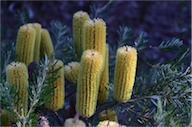Information about plants in flower this week
A news sheet prepared by a Gardens' volunteer, featuring the flowers, fruits and foliage of a selection of plants in the Australian National Botanic Gardens .
Numbers before each plant refer to temporary IFTW labels in the gardens.
Numbers in square brackets [ ] refer to garden bed Sections. Featured plants are in bold type.
View past issues of 'In Flower This Week'.
27 April - 10 May 2016
Today we will start our walk from the café to see some of the Gardens' wonderful banksias in flower.
- On your left as you leave the cafe is Banksia spinulosa 'Stumpy Gold' [Section 131], with fine, toothed linear foliage and masses of short gold cones with rusty red styles. This plant is a dwarf cultivar of Banksia spinulosa var. collina from material collected on the New South Wales Central Coast.
- Banksia spinulosa 'Coastal Cushion' [Section 131], also on your left, has pale yellow cones on a prostrate bush of bright green foliage. It is a coastal form of Banksia spinulosa.
- Further on your left is Banksia ericifolia 'Golden Girl' [Section 131], a large bush with bright gold cones and upright "heathy" foliage which is more blue-green than other B. ericifolia cultivars.
- Banksia spinulosa var. collina [Section 131], on the corner on your left, has fine linear foliage and slender, dull gold cones. This shrub, commonly known as Hill Banksia or Golden Candlesticks, grows along the east coast of Queensland and New South Wales.
- Turn left up the road to see on your left Banksia spinulosa var. spinulosa [Section 131], or Hairpin Banksia, which is found in open forests and woodlands of the coasts and mountains of New South Wales and Queensland.
- Bear right towards the Main Path, then turn left up the hill to see on your left Banksia ericifolia subsp. ericifolia [Section 30], a long-flowering, medium-sized shrub with attractive divided foliage and long orange inflorescences. It is native to New South Wales, but has naturalised in small numbers in Victoria.
- Banksia heliantha [Section 30], which was known as Dryandra quercifolia until the 2007 reclassification of all dryandras to banksias, is on your right. It has stiff spiky foliage and a magnificent green bud erupting from a rusty red base which becomes a yellow flower. It is native to southwestern Western Australia near Esperance.
- Banksia spinulosa 'Birthday Candles' [Section 30] is on your left, a dense bright green bush with attractive needle foliage and short yellow cones with rusty red styles.
- On your right is Banksia spinulosa 'Honeypots' [Section 30], a medium-sized bush with fine, upright toothed foliage and many gold cones with red styles and a strong honey fragrance.
- Also on your right is Banksia integrifolia subsp. integrifolia [Section 30] or Coast Banksia, a small tree with yellow cones with grey tips. It occurs in the wild on the east coast of mainland Australia.
- Almost under the tree, also on your right, is Banksia integrifolia subsp. integrifolia prostrate form [Section 30], a vigorous groundcover with dark green leaves with silver backs. There are upright yellow-green cones on this versatile and hardy plant native to coastal eastern mainland Australia.
- Banksia conferta subsp. penicillata [Section 25], or Newnes Plateau Banksia, on your left is a small tree covered in short green cones with grey ends to the flowers and a velvety brown tip protruding from the top of the cone. This plant is found in a restricted area of the Blue Mountains, New South Wales.
- Banksia spinulosa var. neoanglica [Section 25], or New England Banksia, is on your left, with silver-backed dark green foliage with yellow/gold upright cones. It is a shrub that grows along the east coast of Queensland and New South Wales.
- Banksia paludosa [Section 27] is on your right, with plain gold cones. It grows naturally in the open forests and woodlands of central and south eastern New South Wales with an outlying population on the north coast near Kempsey.
- Banksia ericifolia 'Red Clusters' [Section 25], on your left, is a small tree with green heath-like foliage and very large orange-red cones.
Rosalind Walcott
![Director of National Parks [logo]](../../../../images/dnp_90px.gif)







